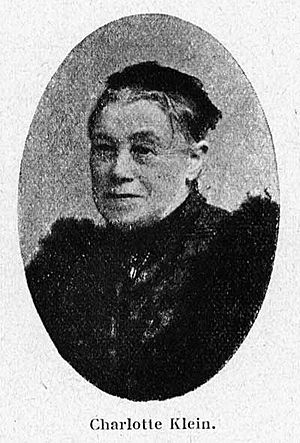Charlotte Klein facts for kids
Charlotte Bolette Klein (1834–1915) was a Danish teacher and a champion for women's rights. She believed women should have more opportunities. From the mid-1870s until 1907, she led the Arts and Crafts School for Women in Copenhagen. Klein was also part of the Danish Women's Society. She strongly supported women's suffrage, which means women getting the right to vote. Before she passed away, she shared her thoughts in a book called Hvad jeg venter af Kvinderne (What I Expect of Women).
Early Life and Education
Charlotte Bolette Unna was born on October 29, 1834, in Helsingør, Denmark. Her father, Simon Unna, was a merchant. Her mother was Johanne Marie Schrøder. Charlotte grew up in a comfortable home. She received a good education, which included piano lessons. From the age of 12, she was very interested in how women could have more opportunities in society.
Working for Women's Rights
When Charlotte was in her thirties, she became good friends with Mathilde Fibiger. Mathilde was a strong supporter of women's rights. Mathilde moved to Helsingør in 1864. Charlotte married the architect Vilhelm Klein in October 1866. Her husband also supported better conditions for women.
Mathilde Fibiger encouraged Charlotte. In 1871, Charlotte became a member of the new Danish Women's Society. This group wanted to create schools. These schools would train women for professional jobs.
Leading the Arts and Crafts School
The Danish Women's Society started the Arts and Crafts School for Women in 1875. Charlotte Klein became its leader. In 1881, the school moved to a new building. Her husband designed this building on H. C. Andersens Boulevard. At first, she taught at the school without pay. With her husband's help, she stayed as the head of the school. She retired in 1907.
Charlotte and Vilhelm Klein did not have their own children. However, they took special care of Sophy A. Christensen. Sophy later became a famous furniture designer.
Charlotte Klein passed away on March 9, 1915. She died in the Frederiksberg area of Copenhagen. She is buried in Assistens Cemetery.


